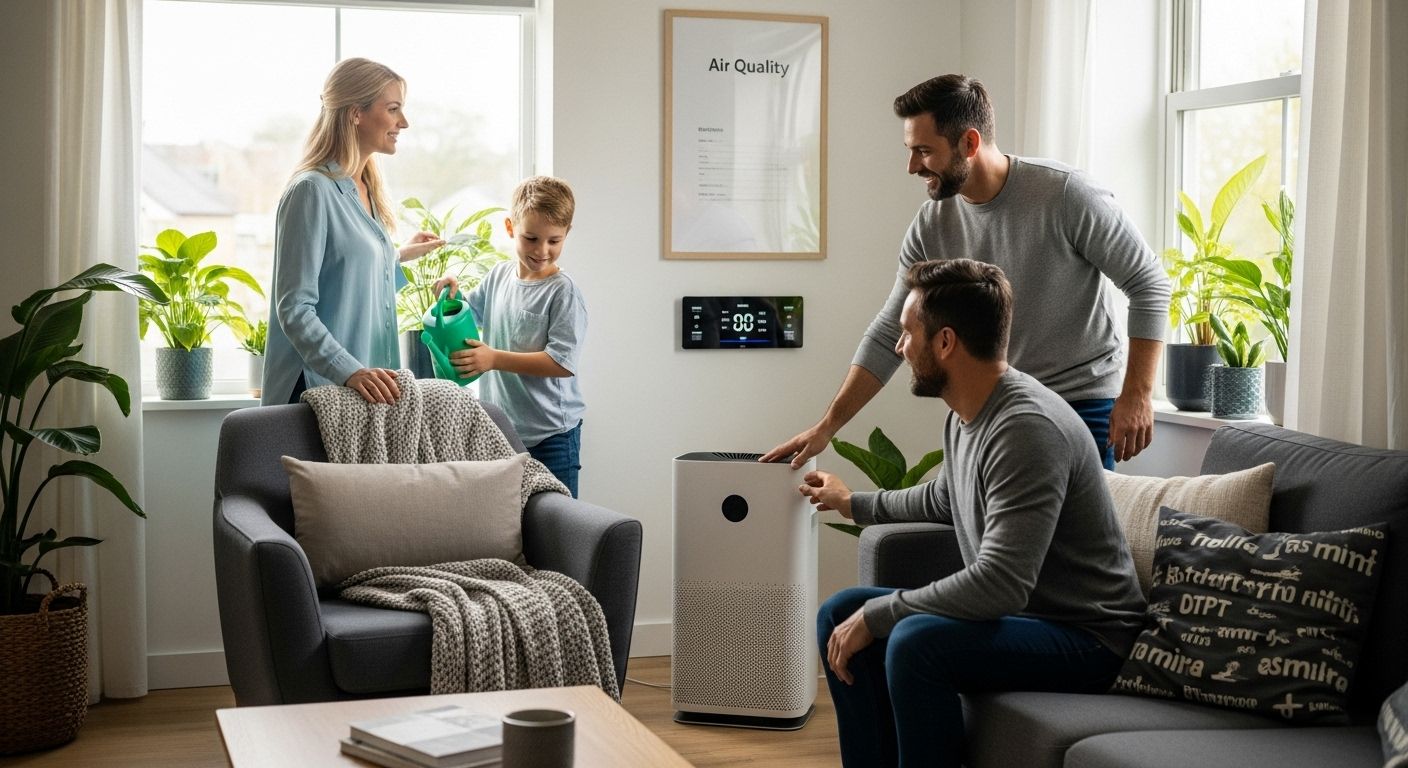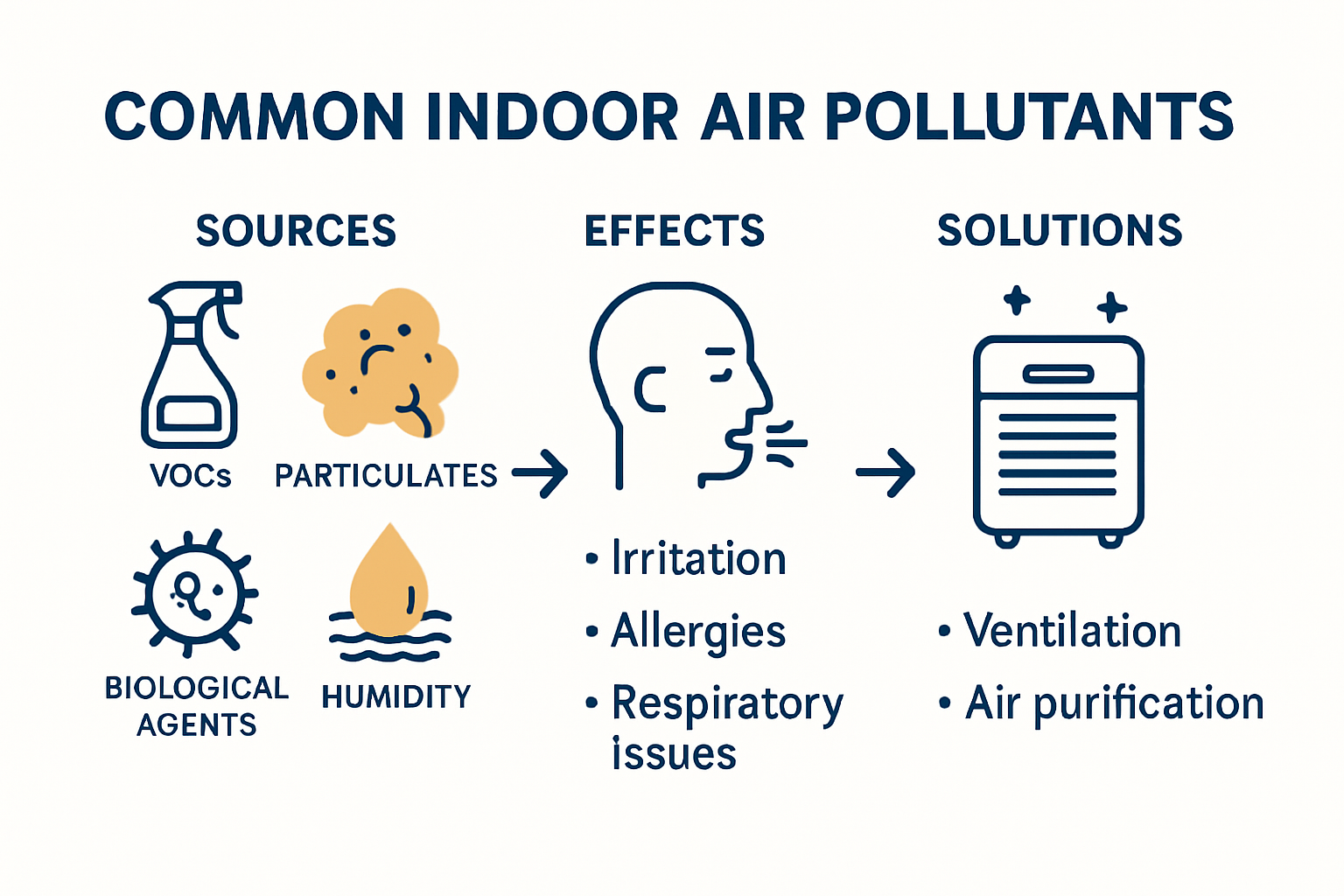Indoor air can look clean yet hide a shocking secret. Americans spend about 90% of their time indoors and indoor air often contains significantly more pollutants than the air outside. You might think the fresh air indoors keeps you safe but the truth is those invisible particles could be impacting your health every single day in ways you never imagined.

Table of Contents
- What Is Indoor Air Quality And Why It Matters
- Key Components Of Indoor Air Quality Explained
- The Impact Of Indoor Air Quality On Health And Productivity
- How Indoor Air Quality Is Measured And Managed
- Strategies For Improving Indoor Air Quality In Various Environments
Quick Summary
| Takeaway | Explanation |
|---|---|
| Indoor air quality impacts health significantly | Poor indoor air quality can result in respiratory issues and other health complications over time. |
| Common pollutants include VOCs and biological contaminants | Volatile Organic Compounds and biological agents like mold can severely affect indoor air quality. |
| Humidity levels affect biological growth | Maintaining humidity between 30%-50% helps manage and control biological contaminants effectively. |
| Regular maintenance improves air quality | Routine HVAC servicing and air filtration can enhance indoor air conditions substantially. |
| Workplace air quality influences productivity | Good indoor air quality leads to better cognitive function and higher workplace efficiency. |
What is Indoor Air Quality and Why It Matters
Indoor air quality represents the environmental condition of the air within and around buildings, directly impacting human health, comfort, and overall well-being. Most people are unaware that indoor spaces can harbor significantly more pollutants than outdoor environments, creating potential risks to respiratory and cardiovascular systems.
Understanding Indoor Air Composition
Indoor air is a complex mixture of gases, particles, and biological compounds that can originate from multiple sources. These include building materials, furniture, cleaning products, human activities, and external pollution that infiltrates indoor spaces. Research from the EPA indicates that Americans spend approximately 90% of their time indoors, making indoor air quality a critical health consideration.
Key components affecting indoor air quality include:
- Particulate matter from dust and outdoor pollution
- Volatile organic compounds (VOCs) from paints and furniture
- Biological pollutants like mold spores and allergens
- Carbon dioxide and other gas emissions
Below is a breakdown of the main types of indoor air pollutants, their typical sources, and potential health effects to help readers identify and understand common contributors to poor indoor air quality.
| Pollutant Type | Common Sources | Potential Health Effects |
|---|---|---|
| Particulate Matter | Dust, outdoor pollution, HVAC systems | Respiratory irritation, asthma, allergies |
| Volatile Organic Compounds (VOCs) | Paints, furniture, adhesives, cleaning products | Headaches, fatigue, respiratory issues |
| Biological Contaminants | Mold, mildew, dust mites, pollen, pet dander | Allergic reactions, infections, asthma |
| Gaseous Emissions | Carbon dioxide, carbon monoxide | Neurological stress, fatigue, illness |
Health Implications of Poor Indoor Air Quality
Poor indoor air quality can lead to immediate and long-term health consequences. Short-term effects might include headaches, fatigue, respiratory irritation, and allergic reactions. Prolonged exposure to indoor air pollutants can contribute to more serious conditions such as asthma, chronic respiratory diseases, and potential cardiovascular complications.
Understanding and managing indoor air quality is not just about comfort but represents a fundamental aspect of maintaining a healthy living and working environment. By recognizing potential sources of indoor air pollution and implementing strategic mitigation techniques, individuals and organizations can significantly improve their indoor environmental conditions.
Key Components of Indoor Air Quality Explained
Indoor air quality is not a singular, simple measurement but a complex interaction of multiple environmental factors that collectively determine the health and safety of interior spaces. Understanding these key components provides crucial insights into managing and improving air quality effectively.
Chemical Pollutants and Particulate Matter
Chemical pollutants represent a significant challenge in indoor environments. Research from the EPA reveals that volatile organic compounds (VOCs) can originate from numerous sources including:
- Paint and building materials
- Furniture and carpet adhesives
- Cleaning products and personal care items
- Printer and office equipment emissions
Particulate matter, another critical component, consists of tiny solid or liquid particles suspended in the air. These microscopic fragments can penetrate deep into respiratory systems, potentially causing significant health complications. Sizes range from large dust particles visible to the naked eye to ultrafine particles that require specialized microscopic detection.
Biological Contaminants and Humidity Interactions
Biological contaminants introduce another layer of complexity to indoor air quality. These include microorganisms such as bacteria, viruses, mold spores, and allergens like pollen and pet dander. Humidity plays a crucial role in their proliferation and survival. Environments with humidity levels between 30% and 50% create optimal conditions for controlling biological contaminant growth.
Key biological pollutants include:
- Mold and mildew spores
- Dust mites
- Bacteria and viruses
- Pollen and pet allergens
The interaction between humidity, temperature, and these biological agents determines their potential impact on human health. Higher humidity can accelerate microbial growth, while extremely dry conditions can create respiratory irritation and increase airborne particle transmission.

Comprehensive indoor air quality management requires a holistic approach that addresses chemical, particulate, and biological components simultaneously. By understanding these intricate interactions, individuals and organizations can develop more effective strategies for creating healthier indoor environments.
The Impact of Indoor Air Quality on Health and Productivity
Indoor air quality is far more than an environmental concern it represents a critical factor influencing human health, cognitive performance, and workplace effectiveness. The invisible nature of air quality makes its impact often overlooked, yet its consequences can be profound and far reaching.
Direct Health Consequences
Prolonged exposure to poor indoor air quality can trigger a range of immediate and long term health complications. Respiratory systems are particularly vulnerable, with potential outcomes ranging from minor irritations to severe chronic conditions. Research from the International Journal of Environmental Research and Public Health demonstrates that indoor air pollutants can significantly compromise individual wellness.
Common health impacts include:
- Increased respiratory infections
- Exacerbation of asthma and allergic reactions
- Potential neurological and cardiovascular stress
- Compromised immune system functioning
Cognitive Performance and Workplace Productivity
Beyond physical health, indoor air quality directly influences cognitive performance and workplace productivity. Poor air quality can lead to decreased mental clarity, reduced concentration, and diminished decision making capabilities. Professionals working in environments with high pollutant levels often experience:
- Reduced cognitive processing speed
- Increased mental fatigue
- Lower problem solving capabilities
- Decreased overall workplace efficiency
The economic implications are substantial. Organizations with superior indoor air quality management can potentially see significant improvements in employee performance, reduced sick days, and enhanced overall workplace wellness.

Understanding and addressing indoor air quality represents a holistic approach to health management. By recognizing its multifaceted impact on human physiology and cognitive function, individuals and organizations can implement strategic interventions that promote healthier, more productive environments.
How Indoor Air Quality is Measured and Managed
Measuring and managing indoor air quality requires a sophisticated, multifaceted approach that combines advanced technological tools, systematic monitoring, and strategic interventions. This comprehensive process enables organizations and individuals to identify, assess, and mitigate potential air quality risks effectively.
Advanced Measurement Technologies
According to OSHA guidelines, indoor air quality assessment involves precise instrumental techniques designed to detect and quantify various pollutants. These sophisticated measurement tools enable comprehensive environmental analysis across multiple parameters.
Key measurement technologies include:
- Particle counters for measuring particulate concentration
- VOC sensors detecting chemical compound levels
- Carbon dioxide and carbon monoxide monitors
- Humidity and temperature tracking instruments
- Biological contaminant sampling equipment
Comprehensive Management Strategies
Effective indoor air quality management transcends simple measurement. It requires a holistic approach that addresses potential contamination sources, implements preventative controls, and establishes ongoing monitoring protocols. Strategic management involves understanding the intricate interactions between building systems, environmental conditions, and human activities.
Critical management components encompass:
- Regular ventilation system maintenance
- Source identification and elimination
- Implementing air filtration technologies
- Controlling humidity and temperature
- Establishing routine air quality assessment schedules
The ultimate goal of indoor air quality management is creating environments that support human health, productivity, and well-being. By combining advanced measurement technologies with comprehensive management strategies, organizations can develop proactive approaches that significantly improve indoor environmental conditions.
Strategies for Improving Indoor Air Quality in Various Environments
Improving indoor air quality requires a nuanced, environment specific approach that recognizes the unique challenges and characteristics of different spaces. From residential homes to commercial offices, each setting demands tailored strategies to effectively manage and enhance air quality.
The table below summarizes the main approaches for improving indoor air quality in residential vs. commercial environments, allowing for quick comparison of strategies suitable for each setting.
| Environment | Key Strategies |
|---|---|
| Residential | Regular HVAC maintenance, HEPA purifiers, control humidity, minimize chemicals, indoor plants |
| Commercial | Advanced ventilation, regular air quality assessments, low-emission zones, strict maintenance, low-VOC materials |
Residential Environment Interventions
Homeowners can implement multiple targeted approaches to mitigate indoor air pollutants. Research from the National Institutes of Health highlights the importance of comprehensive air quality management strategies that address multiple contamination sources.
Key residential strategies include:
- Regular HVAC system maintenance and filter replacement
- Using high efficiency particulate air (HEPA) purifiers
- Controlling indoor humidity levels
- Minimizing chemical based cleaning products
- Introducing indoor plants that naturally filter air
Commercial and Workplace Strategies
Workplace environments present more complex air quality challenges due to multiple occupants, diverse activities, and intricate building systems. Strategic interventions focus on systematic approaches that blend technological solutions with proactive management practices.
Critical workplace air quality improvement techniques involve:
- Implementing advanced ventilation systems
- Conducting regular indoor air quality assessments
- Creating designated low emission zones
- Establishing strict maintenance protocols
- Utilizing low volatile organic compound (VOC) materials
Effective indoor air quality improvement transcends simple technological solutions. It requires a holistic understanding of environmental interactions, human behaviors, and systematic management approaches. By adopting comprehensive, context specific strategies, organizations and individuals can create healthier indoor environments that support well being and productivity.
Protect Your Workplace Air and Image with Essential Floor Mat Solutions
Are you worried about the impact of indoor air quality on your employees’ health and productivity? The article highlights how dust, allergens, and particulates can silently contribute to poor indoor environments and ongoing health issues in high-traffic spaces. Many commercial and industrial areas struggle to control these pollutants, which are often brought in and spread through foot traffic. Choosing the right matting can play a critical role in reducing airborne contaminants and supporting a cleaner workspace.
At Mats4U.com, our expertly designed commercial floor mats help trap dirt, dust, and moisture before they circulate into your building and impact your indoor air quality. Invest in robust floor mat solutions that support a healthier environment and protect your business image. Act now to make your workspace safer and cleaner. Discover your perfect mat today by visiting our main store and see how easily you can enhance the quality of your indoor environment.
Frequently Asked Questions
What is indoor air quality, and why is it important?
Indoor air quality refers to the condition of the air within buildings, affecting human health, comfort, and overall well-being. It is important because poor indoor air quality can lead to respiratory issues, allergic reactions, and other health complications.
What are common sources of indoor air pollutants?
Common sources of indoor air pollutants include volatile organic compounds (VOCs) from paints and cleaning products, particulate matter from dust and outdoor pollution, biological contaminants like mold spores and allergens, and gas emissions like carbon dioxide.
How can I improve indoor air quality in my home?
To improve indoor air quality at home, you can regularly maintain your HVAC system, use high-efficiency particulate air (HEPA) purifiers, control humidity levels, minimize the use of chemical-based products, and introduce indoor plants that help filter the air.
What measurement technologies are used to assess indoor air quality?
Measurement technologies for assessing indoor air quality include particle counters, VOC sensors, carbon dioxide and carbon monoxide monitors, humidity and temperature trackers, and sampling equipment for biological contaminants.







